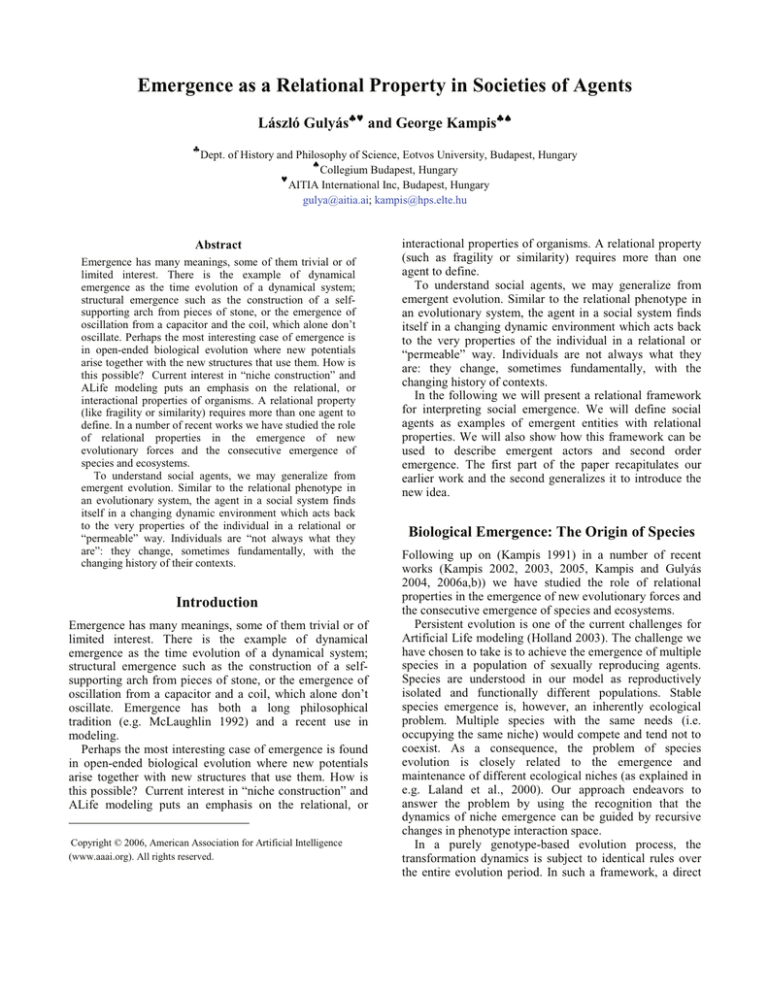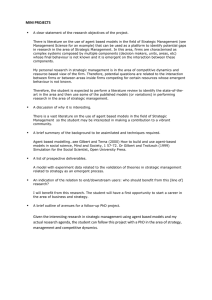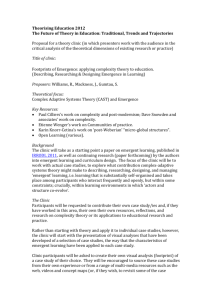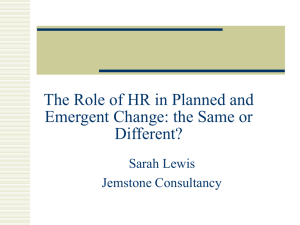
Emergence as a Relational Property in Societies of Agents
László Gulyás♣♥ and George Kampis♣♠
♣
Dept. of History and Philosophy of Science, Eotvos University, Budapest, Hungary
♠
Collegium Budapest, Hungary
♥
AITIA International Inc, Budapest, Hungary
gulya@aitia.ai; kampis@hps.elte.hu
Abstract
Emergence has many meanings, some of them trivial or of
limited interest. There is the example of dynamical
emergence as the time evolution of a dynamical system;
structural emergence such as the construction of a selfsupporting arch from pieces of stone, or the emergence of
oscillation from a capacitor and the coil, which alone don’t
oscillate. Perhaps the most interesting case of emergence is
in open-ended biological evolution where new potentials
arise together with the new structures that use them. How is
this possible? Current interest in “niche construction” and
ALife modeling puts an emphasis on the relational, or
interactional properties of organisms. A relational property
(like fragility or similarity) requires more than one agent to
define. In a number of recent works we have studied the role
of relational properties in the emergence of new
evolutionary forces and the consecutive emergence of
species and ecosystems.
To understand social agents, we may generalize from
emergent evolution. Similar to the relational phenotype in
an evolutionary system, the agent in a social system finds
itself in a changing dynamic environment which acts back
to the very properties of the individual in a relational or
“permeable” way. Individuals are “not always what they
are”: they change, sometimes fundamentally, with the
changing history of their contexts.
Introduction
Emergence has many meanings, some of them trivial or of
limited interest. There is the example of dynamical
emergence as the time evolution of a dynamical system;
structural emergence such as the construction of a selfsupporting arch from pieces of stone, or the emergence of
oscillation from a capacitor and a coil, which alone don’t
oscillate. Emergence has both a long philosophical
tradition (e.g. McLaughlin 1992) and a recent use in
modeling.
Perhaps the most interesting case of emergence is found
in open-ended biological evolution where new potentials
arise together with new structures that use them. How is
this possible? Current interest in “niche construction” and
ALife modeling puts an emphasis on the relational, or
Copyright © 2006, American Association for Artificial Intelligence
(www.aaai.org). All rights reserved.
interactional properties of organisms. A relational property
(such as fragility or similarity) requires more than one
agent to define.
To understand social agents, we may generalize from
emergent evolution. Similar to the relational phenotype in
an evolutionary system, the agent in a social system finds
itself in a changing dynamic environment which acts back
to the very properties of the individual in a relational or
“permeable” way. Individuals are not always what they
are: they change, sometimes fundamentally, with the
changing history of contexts.
In the following we will present a relational framework
for interpreting social emergence. We will define social
agents as examples of emergent entities with relational
properties. We will also show how this framework can be
used to describe emergent actors and second order
emergence. The first part of the paper recapitulates our
earlier work and the second generalizes it to introduce the
new idea.
Biological Emergence: The Origin of Species
Following up on (Kampis 1991) in a number of recent
works (Kampis 2002, 2003, 2005, Kampis and Gulyás
2004, 2006a,b)) we have studied the role of relational
properties in the emergence of new evolutionary forces and
the consecutive emergence of species and ecosystems.
Persistent evolution is one of the current challenges for
Artificial Life modeling (Holland 2003). The challenge we
have chosen to take is to achieve the emergence of multiple
species in a population of sexually reproducing agents.
Species are understood in our model as reproductively
isolated and functionally different populations. Stable
species emergence is, however, an inherently ecological
problem. Multiple species with the same needs (i.e.
occupying the same niche) would compete and tend not to
coexist. As a consequence, the problem of species
evolution is closely related to the emergence and
maintenance of different ecological niches (as explained in
e.g. Laland et al., 2000). Our approach endeavors to
answer the problem by using the recognition that the
dynamics of niche emergence can be guided by recursive
changes in phenotype interaction space.
In a purely genotype-based evolution process, the
transformation dynamics is subject to identical rules over
the entire evolution period. In such a framework, a direct
modeling of genetic emergence of species could be a very
difficult, if not impossible task, unless new and flexible
selection forces are introduced from the outside. As
opposed to that, phenotype-based evolution does not suffer
from the same difficulty. In natural evolution, selection
processes are exerted via the phenotype, the interactor,
which is less rigidly defined. The relation between the
“hard” genotype and the “soft” phenotype is given by
ontogeny and ecological context, both of which come with
enough flexibility to feed back to the evolutionary process.
Of the two candidates, we are concerned with the second.
The interaction space of the phenotypes is itself an
evolutionary product. This can be easily understood in a
simple example such as sexual selection. What counts as a
relevant variable in the pairing of two organisms is, in one
individual, a matter of the other individual’s interacting
variables. Mating will occur when the two sets of variables
fit. If the female prefers male antlers (variable 1) and the
male possesses such antlers of suitable size (variable 2), a
fit or match is possible and reproduction can occur,
propagating both the genotypes and the phenotypes. Such a
match is “groundless”, however. It is based on the
relational properties of the two phenotypes alone. The
same characteristic of sexual selection is, we suggest, a
suitable metaphor for more general ecological and
evolutionary interactions.
Fig 1. Without changes of the interaction
dimension, the population tends to develop into one
single stable species, which is characterized by a
self-developed center and a typically normal
distribution of the property (or phenotype) vectors.
The interactional framework presented is a natural tool
for discussing the problem of the production of species. In
a sexual selection-based species, evolution can transform
or split a population if genetic mutations produce
individuals with a new phenotype that slightly redefines
interactions (e.g. a new female that prefers large body size
instead of antlers). With the introduction of such
“dissenter” individuals, silent phenotype traits in some or
all other individuals (body size in the given example)
become suddenly activated and become part of a changed
ecological interaction space. Typically, all individuals will
be affected by such a transition as they are all potential
mating partners of the dissenter; some will be preferred,
while others not. As a result, the existing sexual selection
pressure will now be supplemented with a new one that
arises spontaneously, endogenously, and within a fully
sympatric (i.e. spatially coextensive) population. The new
sexual selection process can lead to the development of a
new best match, and, consequently, to a new, sexually
reproducing, stable (sub)population reproductively isolated
from the original population.
Based on this theory, we constructed the FATINT
family of agent-based models using the RePast simulation
package. (North et al. 2006). We performed experiments
with populations of sexually reproducing gender-less
individual agents (modeled on organisms such as snails)
where ecological properties were represented by phenotype
vectors. The intended interpretation is that components of
the phenotype vector stand for the currently active (“turned
on”) ecological interactions. Mating success was
introduced in the system as a function of a similarity
measure (e.g., defined as an inverse distance metric over
phenotype vector pairs). To establish a basic evolutionary
setting characterized by variability, a population turnover
and overlapping generations, every individual was
equipped with a minimal “physiology” that required it to
consume food (supplied externally in the form of ”energy”)
and to undergo ageing, leading ultimately to death
(modeled as a progressive failing of the efficiency of
energy processing). Reproduction was represented in the
model as the spawning of new agents accompanied by a
crossing over and mutation rate, both operators executed
directly on the phenotype vectors (i.e. the underlying
ontogeny was trivial).
In the FATINT model family, phenotype vectors are
understood as variable length records that remain fixed
during the lifetime of an agent but have plasticity
otherwise. Interaction change is represented as the change
of the dimensionality of the phenotype vector at the birth
of a new “dissenter” agent. The semantics of interaction
change implies that the transformation of dimensionality
introduced in one individual, is swept instantaneously
across the whole population, which corresponds to the
global nature of the concept of interaction space.
Fig. 2. Evolution of species in the FATINT system,
using a type-dependent phenotype trait
assignment method. The chart shows the average
number of species (over 10 runs) versus time.
Error bars show minimum and maximum values.
As long as dimensionality change is prohibited in the
FATINT system, the population when started from a seed
of agents with randomly selected phenotypes tends to
develop into one single stable species (Fig. 1.). The stable
population is characterized by a self-developed center and
a normal distribution. The internal introduction of new
interaction dimensions, on the other hand, facilitates the
spontaneous development of more species, i.e. subpopulations with different emergent foci, and
reproductively isolated from each other.
In the technology of modeling interaction changes a key
issue is the assignment of new phenotype traits to the new
interaction dimensions. We performed experiments with
both type- and non-type based value assignment methods
(in other words, with systems where individuals having an
identical genotype underwent identical phenotype
modification, and where this constraint was relaxed). We
found that the emergence of new species was affected but
did not fundamentally depend on the choice of the
particular solution. (Figs. 2 and 3.)
Fig 3. Evolution of species in the FATINT system,
using a type-independent phenotype trait
assignment. The chart shows the average number
of species (over 10 runs) versus time. Error bars
show minimum and maximum values.
Abstracting Away: The Relational
Framework
Our approach to species emergence suggests a general idea
that goes beyond biology. Relational properties are ones
that can only be defined on pairs or n-tuples and higher
aggregates of entities. A simple example is distance (which
needs two points to be definable). Another obvious
example is a self-supporting structure such as an arch or a
bridge as formed by a set of stones when arranged suitably
(i.e. brought into the right spatial relation). A less obvious
example may be that of biological phenotype. The notion
of phenotype expresses the ecological interaction potential
of the organism: this notion summarizes those organismic
properties that are “seen” by the environmental
interactions. Hence the other name, that of interactor
(Dawkins 1982). An interactor can be quite complicated
(in the beaver, even the dam is a part of it), still, many
existing features of the organism are excluded from it at
any time (for instance, the beaver uses only anal gland
secretion for individual identification; visual cues and
hence visual properties play little role).
What is included in and excluded from the phenotype
(i.e. the underlying foreground/background separation) is a
matter of physical context, defined by inorganic factors
together with the other organisms acting in the same
ecosystem: by climate, chemical environment, etc., on the
one hand, and species members, predator and prey
organisms, etc. on the other. In short, the phenotype is a
relational product of contextual definition and the key
phenomenon is that of dynamic formation and break-up of
relations.
The relational framework solves a perennial problem of
emergence in modeling and simulation. In a completely
specified system, nothing can really emerge in the literal
sense unless it is a consequence of the pre-specified rules
of the model. The result (and for many, the final
conclusion) is that either emergent phenomena are
completely excluded (such as in a mechanistic modeling
conception) or emergent events appear as encoded in the
starting definition (e.g. a priori rules for emergence).
Whereas a priori rules for emergence may sometimes be
justified by empirical observation of similar past events (as
in post hoc modeling), in social and biological systems the
true fascination lies with the novel or “open” future
developments.
Relational emergence now permits a combination of
mechanistic definition with emergent modeling in the
sense that it allows for the dynamic combination of
preexisting components into new properties understood as
interaction products.
Relational thinking and relational modeling pose slightly
different problems, however. Relational thinking offers a
framework for understanding emergent phenomena,
whereas relational modeling is a tool for producing them in
a model environment such as FATINT. In the former case,
the situation is that of a growing definition space based on
the observation of relational interactions. Each time a
dynamic new relation occurs (i.e. a new “handshaking”
phenomenon takes place, where two formerly unrelated
objects become dynamically related) a new relational
property can be defined, resulting in a changing, most
often growing, property space of the entities. In relational
modeling, on the other hand, the question is how to design
computational methods for the introduction of the
dynamically defined or “emergent” properties.
Whereas there is no general method at hand to cope with
the latter problem (and perhaps none is conceivable), a
method of choice can be a random property assignment, or
a bottom-up grounding of relational properties at a micro
level definition. We review these possibilities:
Method 1: Random property assignment
An example for this method is the use of an entirely
abstract setting where property vectors (feature vectors) of
changing dimensionality are used (Kampis and Gulyás
2004). Then, relational events can be naturally interpreted
as new slots introduced in a feature vector filled in with
randomly assigned values under an ignorance-based
interpretation of randomness (i.e. assuming that the
modeler lacks information about the detailed “physical”
process). The method has an advantage of being simple,
and a disadvantage of being typically all-too-ignorant: it
fails to say anything about the “semantics” of the random
properties, on other words, the method does not suggest a
translation from the set of possible property values to the
set of possible interactions the system.
Method 2: Relational “physics”
The other method uses a detailed definition of interactors
to predict the relational properties at the entity level from
isolated properties defined at the sub-entity level. To use
an inanimate example, fragility as a relational property
emerges when bodies establish physical contact. Modeling
bodies as collections of interacting sub-entities (e.g.
molecules) may allow for the prediction of rigid or elastic
collision and hence the assessment of the fragility value of
a given body with respect to another (such as glass against
the ground). The method has the advantage of being
transparent: emergent properties are just defined but also
explained by it. On the other hand, the method has obvious
limitations as some relational properties may require an
overwhelming amount of physical details to derive. Every
natural system (which contains “everything”) is its best
model (popularized by e.g. Brooks 1991), but scientific
modeling is done exactly because we do not want to deal
with everything. Where there can be no hope for a feasible
and economic bottom-up representation to derive relational
properties, essentially method 1 remains as a choice.
Emergent Actors and Second Order
Emergence
Emergent actors
Of recent interest are “emergent actors” (Cederman 1997,
Gilbert 2002) in agent based systems. An agent is a
compact, encapsulated unit of information and action.
Societies of agents can show collective behaviors and
produce emergent phenomena. Collections of agents
arising from interaction and behaving as new encapsulated
units are conceptualized as emergent actors. Examples for
emergent actors are societal institutions (such as the federal
bank or the family), or organisms (such as the cell in a
biochemical network or the animal in an ecological
system). Emergent actors are entities real in the same sense
as higher-level natural objects such as macroscopic bodies.
A table or a hammer is a collection of atoms. The family is
a collection of individuals. Yet both exist as independent
entities at the same time, because atoms (or family
members) act in coordinated manners in them.
Second order emergence
Emergent phenomena may often be epiphenomena, that is,
phenomena having a zero or minimal importance. For
instance, collective behaviors in emergent actors can
produce coherent patterns, A coherent pattern is nothing
but a stable entity (an example is a city in an urban
dynamics model, or Dennett’s oft-cited swallow in the
Conway Cellular Automaton, Dennett 1995) without any
effect on the process that defines it. In biological and social
systems emergent actors are seldom so inactive, however.
Real organisms (and real cities) become themselves
conditions that further affect the future of the system.
Second order emergence (Gilbert 1995) is a concept that
expresses this idea: when emergent objects act back on the
underlying dynamics that defines (and maintains) their
emergence. Closely related is another notion, that of
downward causation (Campbell 1974 for a classical
introduction and Emmeche et al. 2000 for a review).
Emergent actors and downward causation
An agent is an entity with a definite causal power.
Emergent actors, if real, must possess such a causal power.
(“What does nothing is nothing”, cf. Bergson 1911).
Downward causation is a concept that formalizes the idea
of “higher level” units having a causal power of their own:
„all processes at the lower level of a hierarchy are
restrained by and act in conformity to the laws of the
higher level” (Campbell 1974).
The causal power of emergent actors must derive from a
version of downward causation, therefore. Yet the causal
system at the “lower level” of agents (such as the
molecules) is already complete, hence downward causation
in the sense of causal overdetermination is an oxymoron.
We elaborate this problem briefly.
Overdetermination and underspecification
The problem of causal overdetermination (Kim 1998)
arises “…when two events are each sufficient to produce
some subsequent event and they both occur”. Higher order
entities and second order emergence or downward
causation pose this problem because they assign causal
powers to the emergent actors, whereas every lower level
event in the system must, by the conventional assumption,
be sufficient to produce other lower level events.
Downward causation is often just a shorthand or a
relabelling of complicated causal processes. An example is
density dependent selection in biological (and social)
systems, the phenomenon where the survival of a given
entity depends not only on its own very properties (such as
genotype and fitness) but also on the numbers by which the
given genotype is represented in the population. If two
types of behaviorally and functionally equivalent
organisms (e.g. the red and the blue one) compete for the
same resource (food, mating partners, etc.) then often the
one that exists in higher numbers wins out, while the other
disappears (leaving all blue or all red). This bistable
behavior is a consequence of the fact that statistical events
occur proportionally to numbers, therefore, an organism in
higher numbers has a greater chance to obtain a resource
even if its own properties (“fitness”) ensure no such
advantage. As a result, the more numerous will survive and
reproduce more successfully, amplifying the differences in
the numbers. Similar phenomena are found in the FATINT
system and discussed under “hypercompetition”. Hypercompetition can apply to a variety of problems from tree
growth to urban development.
Here, seemingly density as an “emergent” or
“aggregate” property controls the system. In this case,
however, the events are completely specified at a micro
level due to the local interactions. Density dependent
phenomena are consequences, rather than reasons of
individual behavior.
A similar idea known from synergetics (Haken 1996) is
the slaving principle. Systems “driven” by the slaving
principle are characterized by long-lasting quantities (that
is, a macroscopic pattern) that “enslave” short-lasting
quantities (i.e.. the individual motion of molecules), and
they can force order on them (thereby becoming "order
parameters"). In a magnetic phase transition the overall
magnetization is such an order parameter: once the
symmetry of magnetic bits is randomly broken the
difference will amplify. Instead of having to deal with
millions of chaotic particles, then, one can focus on the
macroscopic quantities (magnetization in the example).
However, slaving modes are not additional to enslaved
modes: the degrees of freedom of the system are reduced
(from the individual micro events to the order parameter),
not increased, as would be suggested in downward
causation.
Is genuine downward causation possible, then? We think
that the problem of overdetermination excludes radical
downward causation, yet a version of downward causation
worth wanting can be approximated as follows.
We have seen a few sections earlier that modeling
(simulation) and the theory building of natural systems can
depart from each other, and so do discovery and
understanding. We also expressed the idea that he map is
not the territory: a model system is never equivalent with
the modeled. Discovering emergent actors in simulations
and understanding them in natural systems are two, related
but distinct, tasks.
This helps us making an important distinction. Causal
overdetermination is not a problem for natural systems.
Their causal power is pre-existent but never completely or
fully analyzed. In other words, in natural causation there is
always “room” for the emergent actors that arise from a
causal inefficacy of an existing, yet undepleted, causal
power. The power of natural emergent actors can, as a
consequence, be explained from the causal power of the
underlying system. In a model, however, clusters of agents
that behave as emergent actors can be discovered, but in
lack of a rich implicit “soil” of unexploited lower entities
the emergent power cannot be spontaneously arise – it has
to be introduced as in Methods 1 & 2. Yet such an
introduction of new, higher level causal elements in the
system does not imply causal overdetermination if
understood properly as the redefinition of the system.
Now we exploit this idea by looking at the points this
may necessary. We suggest indexical clusters as a solution.
Relational Interpretation of Emergent Actors
Indexical variables
An indexical variable is a quantity that stands for another
quantity so that it can replace the latter for measurement.
By the traditional coil-based meter voltage is measured by
the displacement on a scale: here distance is an indexical
variable for voltage. Indexical variables play a fundamental
role in science because most quantities are measured
indirectly. Behind every indexical variable there is a
(preferably one-to-one) mapping (or “measurement
theory”) between the indexical variable and the original
variable it replaces. The measurement theory for the
voltage meter is an equation that relates displacement on
the scale to voltage applied at the input.
Emergent actors as clusters of indexical variables
A family or an organism is an emergent actor in that it acts
as one single entity from a given point of interest. In terms
of indexical variables, this can be easily expressed in a
form that allows for an operational identification of
emergent actors in a system.
For a rabbit, the cast shadow of an eagle predicts the
whole eagle together with the biting of the beak. It is
sufficient to examine and detect the shadow (or a single
feather) to predict or compute the future: the eagle will or
may attack. The eagle is an emergent actor in the
biosystem, composed of a number of components (cells,
molecules etc). There is no need (or possibility) for the
rabbit (or for the scientist) to follow these individual
elements one by one. Each element can stand for all the
rest: any chosen part of the eagle can be thought of as an
indexical variable for any other. Together, they form a
naturally defined cluster.
An emergent actor thus appears to be a cluster (or, in
other words, an aggregate) of indexical variables. The
cluster extends to the transitive closure of all elements that
can be used as indexical variables for one another.
Then we can reverse things around. In a system of
interacting components, an emergent actor arises (is
defined) when components start to behave coherently, i.e.
when they can be taken as parts of one single entity: in
other words, where one component can be used as
indexical variable for another. By seeking for indexical
clusters, we effectively seek for emergent actors.
At the cognitive level, the search for indexical clusters
can be understood as actions that improve processing
efficiency. Instead of the constant monitoring of all
possible (indexical) variables, the agent detects only a few
of them and understands (predicts) the behavior of the
entire ensemble, i.e. the emergent actor. For example, the
actions of the United Nations can be well proxied by the
statements made by its Secretary General. Indeed, the close
following of actions by all UN entities is simply
impossible. The key here is the understanding of the
function of the cluster: the measurement theory of the
eagle or of the UN is the theory of its behavior.
Admittedly, this is a methodologically individualist
approach to emergent actors. We are assuming that
emergent actors are composed of individual agents that act
in a concerted fashion. However, at the same time we also
impose a cognitive structure at the agent level that
associates the detected actions of a single indexical
variable (agent) with the actions of the ensemble of agents
consisting the emergent actor.
There is a way to view this as a version of selfsimplifying property in systems. Note that clusters of
indexical variables are not discretional descriptions but
well-defined consequences of temporal dynamics. Hence
the introduction of higher level entities via indexical
clusters (and the subsequent simplification of the system’s
description) is well grounded in the system itself. This
remark is of exploratory nature and needs further
elaboration in future work.
Relational Emergence of Actors
We can now formulate our arguments using the relational
framework introduced earlier. There we argued that
relational emergence allows for the dynamic combination
of fully specified parts, yielding to an open-ended
evolution of novel phenomena. For example, species in the
FATINT system are only defined in such relational terms.
That is, they are understood as the transitive closure of
mating capability, which derives from relational
(similarity) properties.
Similarly, emergent actors can thus be defined as a
closure of a specific relation or combination of relations.
For example, a person’s standing with respect to a
political party is, in fact, the person’s position relative to
the perceived acts and statements of an ensemble of,
strongly interrelated, agents, the party members and
officials.
example of biological evolution. The key ideas are:
relational definition and indexical clusters.
Relational definition allows us to overcome notorious
problems usually associated with emergent phenomena,
such as the problem of downward causation and secondorder emergence. On the other hand, the relational view of
entities introduces a difference between the description and
the modeling of systems. The relational view is easy to
accommodate in a post hoc description where the dynamic
change of relational properties can be seen as a
consequence of inevitably incomplete description. In a
model, however, the same phenomenon necessitated the
redefinition of the system and the introduction of new
information. We discussed indexical clusters as tools to
support this modeling operation. Indexical clusters are
transitive closures of those elements in a system that can
predict each other’s behaviors. Emergent agents can be
characterized as indexical clusters, hence points of
relational emergence can be associated with the
identification of such clusters in the course of dynamics.
Exploration of these ideas in modeling experiments and
the elaboration of some of the consequences is left to
subsequent papers.
Acknowledgments
Research reported in this paper was partially supported by
the EU FP6 IST STREP QosCosGrid (Contract Number
033883) and by the Hungarian Government under the grant
GVOP-3.2.2-2004.07-005/3.0
(ELTE
Informatics
Cooperative Research and Education Center). Computer
simulations were done on the BeoWulf cluster of the
Center for Complex Systems Studies, Physics Department,
Kalamazoo College, MI, as well as on the SUN E10K,
E15K system of Hungary’s NIIF Supercomputing Center.
The supports are gratefully acknowledged.
Second Order Emergence
The relational interpretation of emergent actors allows us
to understand second order emergence as well. Actions by
the emergent actor might influence its constituents or other
‘first level’ agents in the system, which is, in fact, the very
kind of influence that defines second order emergence.
Using the terminology we introduced earlier, we can
reformulate this as follows. Second order emergence is
achieved when the considerations feeding the agent-level
decision making process involve indexical variables that
are used for predicting further variables belonging to the
same clusters that form an emergent actor. (This may,
however, not be the only mechanism that yields second
order emergence.)
Conclusions
We have presented a framework for the characterization of
emergent phenomena and emergent agents in social
systems on the basis of considerations abstracted from the
References
Bergson, H. 1911. Creative Evolution, translated by Arthur
Mitchell. New York: Henry Holt and Company.
Brooks, R.A. 1991: Intelligence Without Representation,
Artificial Intelligence 47, 139–159.
Campbell D.T. 1974. 'Downward causation' in
Hierarchically Organized Biological Systems. In: Studies
in the Philosophy of Biology, F.J. Ayala & T. Dobzhansky
(ed.). New York: Macmillan Press, 179-186.
Cederman, L-E. 1997. Emergent Actors in World Politics:
How States and Nations Develop. Princeton, NJ: Princeton
University Press.
Dawkins, R. 1982. The Extended Phenotype: The Long
Reach of the Gene. Oxford: Oxford University Press.
Dennett, D.C. 1995. Darwin’s Dangerous Idea. New York:
Simon and Schuster.
Emmeche, C.; Koppe, S.; and Stjernfelt, F. 2000. Levels,
Emergence, and Three Versions of Downward Causation.
In: Andersen, P.B., Emmeche, C., Finnemann, N.O. and
Christiansen, P.V. (eds.) Downward Causation. Minds,
Bodies and Matter. Aarhus: Aarhus University Press, 1334.
Gilbert, N. 1995. Emergence in social simulation. In:
Gilbert, N. and Conte, R. (eds.): Artificial Societies: the
Computer Simulation of Social Life, London: UCL Press.
Gilbert, Nigel 2002. Varieties of emergence. Paper
presented at the Agent 2002 Conference: Social agents:
ecology, exchange, and evolution, Chicago.
Gulyás, L.: On the Transition to Agent-Based Modeling:
Implementation Strategies From Variables To Agents,
Social Science Computer Review. 20: 389-399.
Gulyás, L. 2003. Relational Agent Models – A Framework
for Modular and Topology-Independent Simulations. Paper
from the talk at Seventh Annual Swarm Users/Researchers
Conference (SwarmFest 2003), Notre Dame, Indiana.
Gulyás L. 2004. Understanding Emergent Social
Phenomena: Methods, Tools and Applications for AgentBased Modeling. PhD Thesis, Eötvös University,
Budapest.
http://hps.elte.hu/~gulya/Research/Thesis/index.html
Gulyás, L., Bartha, S. 2005. FABLES: A Functional
Agent-Based Language for Simulations. In Proceedings of
The Agent 2005 Conference on: Generative Social
Processes, Models, and Mechanisms, Argonne National
Laboratory, Chicago, IL, USA.
Haken, H. 1996: The Slaving Principle Revisited. Physica
D 97, 95-103.
Holland, J.H. (2003): Challenges for Agent-based
Modeling,
http://www.nd.edu/~swarm03/Keynote/keynote.html
Kampis, G. 1991. Self-Modifying Systems: A New
Framework for Dynamics, Information, and Complexity,
Oxford-New York: Pergamon, pp 543+xix.
Kampis, G. 2002. A Causal Model of Evolution. In Proc.
SEAL 02 (4th Asia-Pacific Conference on Simulated
Evolution And Learning), Singapore, 836—840.
Kampis, G., 2003. Towards an Evolutionary Technology
(JAIST working paper, in Japanese). English version:
http://www.jaist.ac.jp/~g-kampis/EvoTech/Towards.html
Kampis, G. 2005. The Evolution of Mechanisms. Talk
given at Indiana University, Bloomington, February 15.
http://hps.elte.hu/~kampis/IU-Kampis.pps
Kampis, G., and Gulyás, L. 2004. Sustained Evolution
from Changing Interaction. In Proceedings of ALife IX,
MIT Press, Boston, 328—333.
Kampis, G., and Gulyás, L. 2006a: Phat Phenotypes for
Agents in Niche Construction. In Proceedings of ALife X,
MIT Press, Boston.
Kampis, G. and Gulyás, L. 2006b: Emergence Out Of
Interaction: Developing Evolutionary Technology For
Design Innovation. Advanced Engineering Informatics,
20 (2006) 313–320.
Kim, J. 1998. Mind in a Physical World: An Essay on the
Mind-Body Problem and Mental Causation. Cambridge,
MA: MIT Press, Bradford Books.
Laland, K.N., Odling-Smee, J. and Feldman, M.W. (2000):
Niche Construction, Biological Evolution and Cultural
Change, Behavioral and Brain Sciences, Volume 23, Issue
01., pp131-146
McLaughlin, B.P. 1992. The Rise and Fall of British
Emergentism. In: Emergence Or Reduction? Eds. A.
Berckermann, J. Kim, and H. Flohr. De Gruyter,, pp.49-93.
North, M.J., N.T. Collier, and J.R. Vos, "Experiences
Creating Three Implementations of the Repast Agent
Modeling Toolkit," ACM Transactions on Modeling and
Computer Simulation, Vol. 16, Issue 1, pp. 1-25, ACM,
New York, New York, USA (January 2006).






